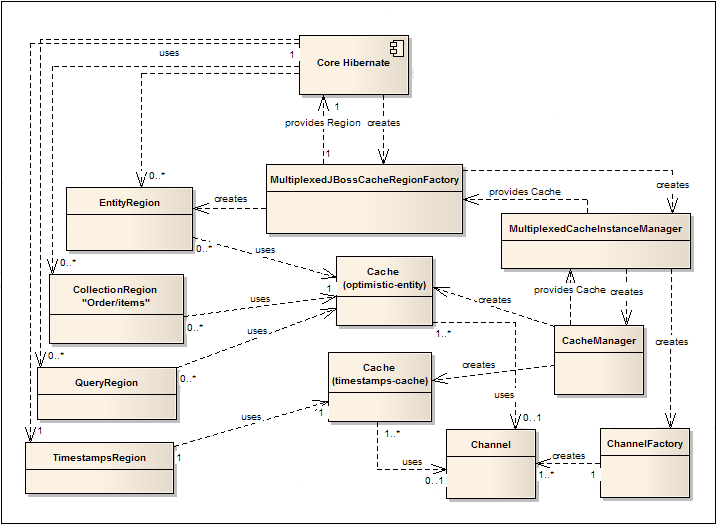自 Hibernate 3.3 开始,二级缓存机制发生重大变化,官方文档中尚未见更新(2008-12-10),仅以此文抛砖引玉!
Hibernate 3.3.0.GA has been released.
A few changes from 3.2 worth noting:
1. Migration to a Maven-based build
2. Splitting of the project into modular jars. This allows users to easily see and minimize dependencies.
3. Redesigned second-level caching SPI
4. Integration with JBossCache 2.x as a second level cache provider.
/**
* Support for pluggable caches.
*
* @author Gavin King
* @deprecated As of 3.3; see <a href="package.html"/> for details.
*/
public interface CacheProvider {...}
This package defines APIs/SPIs and implementations for the Hibernate second-level cache.
The legacy (and now deprecated) approach to caching is defined by the {@link org.hibernate.cache.CacheProvider} and {@link org.hibernate.cache.Cache} interfaces as well as the {@link org.hibernate.cache.CacheConcurrencyStrategy} interface along with the various implementations of all these interfaces. In that scheme, a {@link org.hibernate.cache.CacheProvider} defined how to configure and perform lifecycle operations in regards to a particular underlying caching library; it also defined how to build {@link org.hibernate.cache.Cache} instances which in turn defined how to access the "regions" of the underlying cache instance. For entity and collection data cache regions, {@link org.hibernate.cache.CacheConcurrencyStrategy} wrapped access to those cache regions to apply transactional/concurrent access semantics.
The improved approach is based on {@link org.hibernate.cache.RegionFactory}, the various {@link org.hibernate.cache.Region} specializations and the two access strategies contracts ({@link org.hibernate.cache.access.EntityRegionAccessStrategy} and {@link org.hibernate.cache.access.CollectionRegionAccessStrategy}). The general approach here is that {@link org.hibernate.cache.RegionFactory} defined how to configure and perform lifecycle operations in regards to a particular underlying caching library (or libraries). {@link org.hibernate.cache.RegionFactory} also defines how to build specialized {@link org.hibernate.cache.Region} instances based on the type of data we will be storing in that given region. The fact that {@link org.hibernate.cache.RegionFactory} is asked to build specialized regions (as opposed to just general access) is the first improvement over the legacy scheme. The second improvement is the fact that the regions (well the ones like entity and collection regions that are responsible for storing {@link org.hibernate.cache.TransactionalDataRegion transactional} data) are asked to build their own access strategies (see {@link org.hibernate.cache.EntityRegion#buildAccessStrategy} and {@link org.hibernate.cache.CollectionRegion#buildAccessStrategy}).
This is all looks a bit complex, so let's show what happens if you just configure the defaults, with query caching enabled:
hibernate.cache.use_second_level_cache=true
hibernate.cache.use_query_cache=true
hibernate.cache.region.factory_class=org.hibernate.cache.jbc2.MultiplexedJBossCacheRegionFactory

To be continued






















 1128
1128











 被折叠的 条评论
为什么被折叠?
被折叠的 条评论
为什么被折叠?








